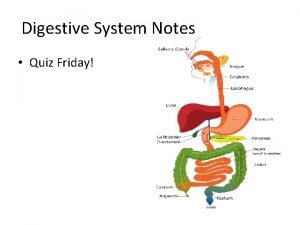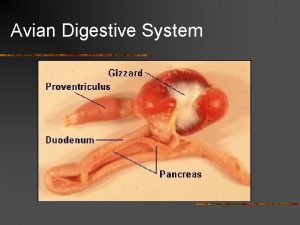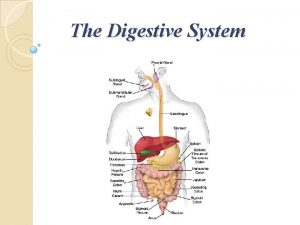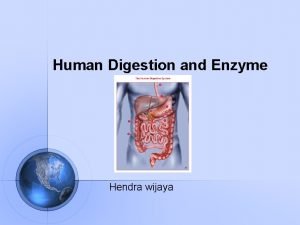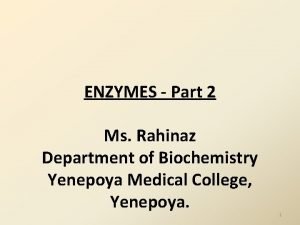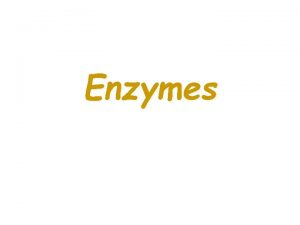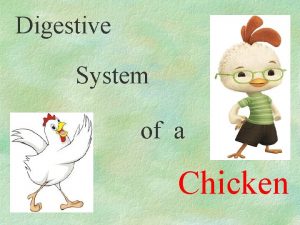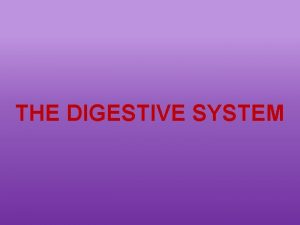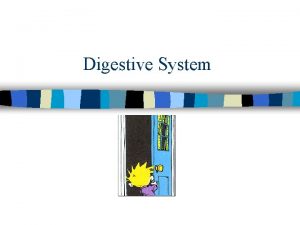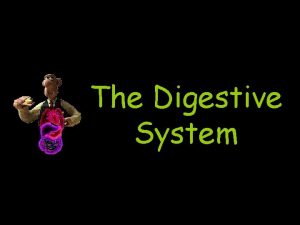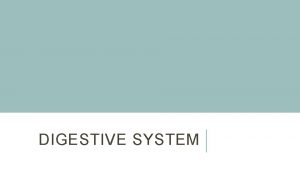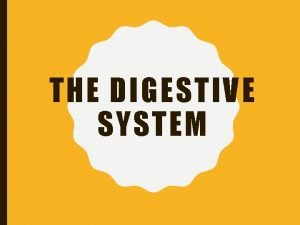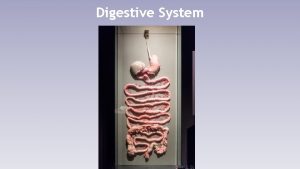Digestive System In Class Notes Functions The digestive


















![Vocabulary: [pictures] Vocabulary: [pictures]](https://slidetodoc.com/presentation_image_h2/a587192dcd323c6e9ab4e4fd1792d7ed/image-19.jpg)
- Slides: 19

Digestive System In Class Notes:

Functions • The digestive system breaks down food for nutrients and energy. • The food is taken through the mouth and then is broken down into small molecules that are converted to energy.

Four Stages of Food Processing • Ingestion-Act of eating or drinking • Digestion-Process of breaking food down into molecules small enough for the body to absorb. • Absorption-Cells take up the small molecules. • Elimination-Undigested material passes out of the body as waste.

Two Types of Digestion • Mechanical Digestion-Chewing that chops and grinds food into small pieces. • Chemical Digestion-Breaks the chemical bonds of large molecules that make up food.

Organs of the Digestive System Mouth: Were digestive system starts Throat: passageway that connects the mouth and the esophagus Esophagus: food passes through it to get to the stomach Stomach: Breaks down food into nutrients Small Intestine: help absorb the nutrients from the 'food' into the bloodstream

Organs Continued Large Intestine: absorb the remaining water from indigestible food matter Rectum: temporary storage facility for feces (waste) Anus: Feces (non-liquid waste products) are expelled from the body through the anus

Pictures

• Ingestion - teeth, tongue, saliva, esophagus (with the help of peristalsis) • Digestion - stomach, liver, pancreas, gallbladder • Absorption - small/large intestines • Elimination - rectum, anus,

Nutrition: (29. 3) • Carbohydrates – Surgars for energy, used by body often • Water – Used in cellular respiration for breaking bonds in sugars • Lipids – Stores more energy than Carbs or proteins. Used by body less often however • Vitamins – Organic molecules used by body paired with enzymes to carry out functions such as growth, repairs, ect… – – • Fat soluble » Stored by the body Water soluble » Cannot be stored by body Minerals – Elements that the body requires in inorganic forms • • Used in small amounts, like vitamins Proteins/ amino acids – Proteins make structure such as hair, make up muscle fibers, and are used for nutrient storage – 8 essential amino acids • Amino acids required for protein production – • Body cant store excess amino acids Fibers – Indigestible • used for poop


Diagram: • Here all the parts:

Parts you should know:

LITTLE BOOKS COLIC WHEN AN INFANT HAS UNCONTROLLABLE CRYING DUE TO STOMACH DISCOMFORT MANY INFANTS GO THROUGH IRT, BUT IT IS ONLY TEMPORARY HERNIA RIPPED TISSUE OFTEN DUE TO HEAVY LIFTING BULGE OR LUMP IN ABDOMEN AREA ALCOHOLIC LIVER DISEASE FEVER, FATIGUE, NAUSEA AND LIVER PROBLEMS DUE TO ALCOHOL ABUSE LACTOSE INTOLERANCE WHEN THE BODY DOESN’T PRODUCE LACTATE(THAT BREAKS DOWN LACTOSE) IT CAUSES NAUSEA, CRAMPS, HEARTBURN, VOMITING AND GENERAL STOMACH DISCOMFORT ACID REFLUX/ GERD ACIDIC STOMACH JUICES FLOW BACK INTO ESOPHAGUS CAUSES IMMFLAMATION IN THE ESOPHAGUS ROTAVIRUS A VIRUS THAT CAUSES VOMITING, WATERY DIARRHEA, FEVER, DEHYDRATION PREVENTED BY WASHING YOUR HANDS

• Malnutrition- a diet lacking in one or more essential nutrients • Undernutrition- deficient in Calories • Obesity- seriously overweight • Anorexia- disorder involving self-starvation • Bulimia- disorder involving bingeing and purging • Bingeing without purging is not a good idea, either.

Function: (29. 1) • Function of the digestive system • 4 stages of food processing (describe each) • 2 types of digestion – Give examples of each

Vocabulary: • Bolus- a chewed clump of food that is pushed down the throat • Peristalsis- a series of muscle contractions when food is pushed down the esophagus • Constipation-a condition of the bowels in which the feces are dry and hardened and evacuation is difficult and infrequent • Diarrhea- an intestinal disorder characterized by abnormal frequency and fluidity of fecal evacuations

Vocabulary: • Nutrition- process of how your body obtains raw materials from food • Ingestion- the act of eating food or drinking; the first stage of food processing • Absorption- uptake of small nutrient molecules; third stage of food processing • Elimination- passage of undigested material from the digestive tract; fourth stage of food processing

Vocabulary: • Feces- undigested food material and other food products • Chyme- liquid mixture of food and stomach fluids release from the stomach into the small intestine • Saliva- liquid secreted into the mouth that contains mucus and digestive enzymes that start chemical digestion • Villus- fingerlike projections of the inner surface if the small intestine that functions in absorbing materials
![Vocabulary pictures Vocabulary: [pictures]](https://slidetodoc.com/presentation_image_h2/a587192dcd323c6e9ab4e4fd1792d7ed/image-19.jpg)
Vocabulary: [pictures]
 Respiratory digestive and circulatory system
Respiratory digestive and circulatory system 4 functions of digestive system
4 functions of digestive system Pathway that food takes through the digestive system
Pathway that food takes through the digestive system Avian digestive system
Avian digestive system Swine digestive system
Swine digestive system Digestive system labeled with functions
Digestive system labeled with functions Diagram of digestive system
Diagram of digestive system Nervous system and digestive system
Nervous system and digestive system Conversion notes brutes en notes standard wisc 5
Conversion notes brutes en notes standard wisc 5 Name the enzymes secreted by small intestine
Name the enzymes secreted by small intestine Examples of enzymes
Examples of enzymes What are enxymes
What are enxymes Hát kết hợp bộ gõ cơ thể
Hát kết hợp bộ gõ cơ thể Bổ thể
Bổ thể Tỉ lệ cơ thể trẻ em
Tỉ lệ cơ thể trẻ em Gấu đi như thế nào
Gấu đi như thế nào Chụp phim tư thế worms-breton
Chụp phim tư thế worms-breton Bài hát chúa yêu trần thế alleluia
Bài hát chúa yêu trần thế alleluia Các môn thể thao bắt đầu bằng từ đua
Các môn thể thao bắt đầu bằng từ đua

